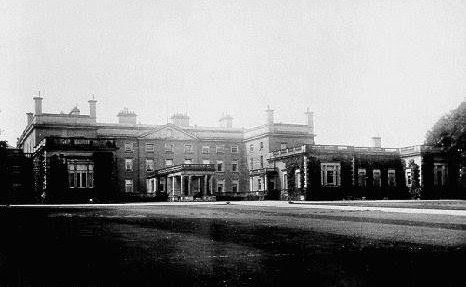A century ago, Lord Howe was reported to be in financial difficulty. It came as no surprise when he sold this country house to a furniture baron, but there were troubled times ahead.

On August 21st 1918, The Pall Mall Gazette reported that the Gopsall estate in Leicestershire, one of the seats of Lord Howe, had been sold to Mr Samuel James Waring. The price was not disclosed, but the elastic figure was somewhere between £300,000 and £400,000. At one time the property had extended to 40,000 acres, but now comprised an area of 12,000 acres, including several villages. Gopsall Hall had sold for about £10,000.

The mansion was built in 1750, long thought to be by John Westley for Charles Jennens (1700-1773), the son of a Birmingham industrialist, at a cost of over £100,000. However, there is now speculation that it might have been the work of William or David Hiorn of Warwick.
Jennens was a keen follower of the arts and allowed his friend George Frederick Handel to stay for a time. Handel was reputed to have composed part of his ‘Messiah’ here and was responsible for the installation of a magnificent organ.

It was inherited by his nephew Richard William Penn Asherton Curzon, whose mother was the eldest daughter of Admiral Howe. In later years, King Edward VII took advantage of the house’s shooting estate (as did Kaiser Wilhelm) and a silver bath was installed prior to his visit. Other visitors included Queen Adelaide during her long widowhood, and Winston Churchill.
A feature of Gopsall were its beautiful ceilings, the one in the dining room occupied nearly the whole space and represented Neptune riding in a nautilus shell drawn by horses.
According to the Pall Mall Gazette, Gopsall ‘may claim a prominent place in the ranks of the stately homes of England’.




The sale, however, played sad havoc with the motto of the Curzons: ‘Let Curzon hold what Curzon held.’ Its new owner couldn’t resist the ‘splitting-up’ movement going on all over the country, and he intimated his willingness to consider proposals from tenants to purchase their holdings.
Samuel James Waring (1860-1940), known as Sir Samuel Waring, Bt, between 1919 and 1922, was a British industrialist, public servant and benefactor. He was the grandson of John Waring, who had arrived in Liverpool from Belfast in 1835 and established a wholesale cabinet maker business. In 1893, Waring was given the task of opening a branch of the family furniture making company in London. In 1897, Waring was responsible for the merger with Gillow and Company to become Waring & Gillow, and of which Waring became chairman.

Seven years later, Waring sold the estate to the Government for £1 an acre and it was transferred to the Crown Estate. It was considered for various uses including that of a motor racing centre, an airfield and a country club. The house remained empty until World War Two when it was used by the No1 Radio Mechanics School of the Royal Electrical and Mechanical Engineers as a radar training base. They left in 1945 and the house was once again abandoned. It suffered several fires in the 1940s, lead was stripped from its roof and many of its fittings stolen as souvenirs. In a poor state of repair, Gopsall Hall was demolished in 1952.
NOTE: The Pall Mall Gazette corrects an error made by most people, me included, that the estate was sold to Samuel Waring in 1919. We now know that it was in 1918.




